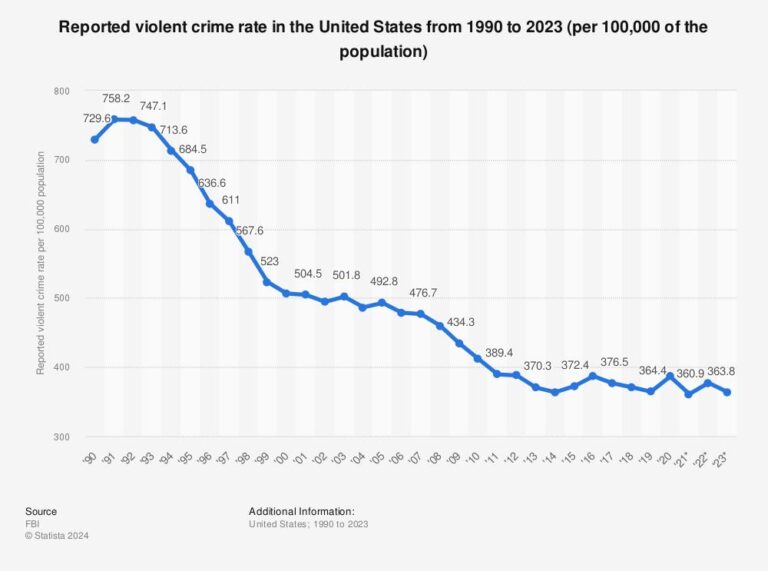The crime rate in the United States remains a critical measure of public safety and social stability, drawing keen attention from policymakers, law enforcement, and citizens alike. According to data compiled by USAFacts, an independent nonprofit organization dedicated to delivering comprehensive and accessible government information, recent trends reveal nuanced shifts in various categories of crime across the nation. This article delves into the latest crime statistics, explores underlying factors, and examines how different regions are impacted, offering a clearer picture of the current state of safety in the US.
Crime Trends in the United States Explored
The landscape of crime in the United States has seen notable shifts over recent years, influenced by socioeconomic factors, policy changes, and community engagement. While violent crimes such as homicide and aggravated assault tend to dominate headlines, property crimes including burglary and larceny represent a substantial portion of reported offenses. According to the latest data, violent crime rates have experienced a fluctuating trend, with some metropolitan areas showing significant decreases, whereas others remain hotspots for crime. Similarly, advancements in law enforcement tactics and technology have contributed to more effective crime prevention and increased clearance rates.
Several key patterns emerge when examining current crime statistics:
- Urban versus rural differences: Urban centers typically report higher incidences of violent crime, whereas rural regions experience lower rates but might face challenges in reporting and resource availability.
- Demographic influences: Age and economic status correlate strongly with certain criminal activities, emphasizing the need for targeted social programs.
- Property crime decline: Over the past decade, property crime rates have generally fallen, attributed to improved security technologies and community policing efforts.
| Crime Type | Change (Last 5 Years) | National Average Rate (per 100k) |
|---|---|---|
| Homicide | +8% | 6.5 |
| Aggravated Assault | -4% | 250.1 |
| Burglary | -12% | 334.7 |
| Larceny-Theft | -9% | 1,185.3 |
Regional Variations and Their Impact on Communities
Crime rates across the United States reveal striking regional differences that deeply influence community safety perceptions and local policies. Urban areas, particularly in the Northeast and Midwest, often report higher incidences of property and violent crimes compared to many rural and suburban regions. These variations are not merely statistical but shape how public resources are allocated—for example, increased law enforcement presence and community outreach programs in cities struggling with higher crime volumes.
Several factors contribute to this disparity, including economic opportunities, population density, and social services availability. Communities experiencing elevated crime rates often face challenges like unemployment and limited access to education, which can perpetuate cycles of crime. Conversely, regions with lower crime tend to benefit from stronger social networks and investment in preventive measures. Below is a snapshot of average regional crime rates per 100,000 residents, illustrating these differences:
| Region | Violent Crime | Property Crime | Impact Highlights |
|---|---|---|---|
| Northeast | 370 | 1,200 | Focus on urban policing and youth programs |
| Midwest | 430 | 1,300 | Economic revitalization and community policing |
| South | 460 | 1,400 | Emphasis on social services and education |
| West | 350 | 1,100 | Investment in mental health and housing |
- Social cohesion: High crime areas often struggle to maintain strong neighborhood bonds, affecting collective efficacy.
- Economic consequences: Crime impacts property values, business investments, and job availability.
- Policy adaptability: Regional data drives tailored approaches, from community policing to rehabilitation initiatives.
Analyzing Contributing Factors Behind the Rising Crime Rates
Recent analyses suggest that the surge in crime rates across various US cities can be linked to a complex interplay of socio-economic challenges and systemic issues. Economic disparities, including rising unemployment and increased poverty levels, have often been cited as primary motivators driving individuals toward criminal activities. Additionally, shifts in community resources and public services, such as reduced funding for youth programs and local policing, have created environments where crime can more easily proliferate. Experts emphasize that these factors do not operate in isolation but rather reinforce each other, exacerbating the overall crime landscape.
- Economic Instability: Higher unemployment correlates with increased property crimes.
- Social Disruption: Community breakdown and weakened social networks contribute to violence.
- Resource Allocation: Cuts in social programs and policing impact crime prevention effectiveness.
- Substance Abuse: Substance dependency often exacerbates criminal behavior.
- Demographic Changes: Urban population shifts and youth demographics influence crime patterns.
| Factor | Impact Level | Crime Type Affected |
|---|---|---|
| Unemployment Rate | High | Property Crime |
| Community Funding Cuts | Medium | Violent Crime |
| Substance Abuse Rates | High | Drug-related Offenses |
| Youth Population Growth | Medium | Juvenile Crime |
Strategies and Policy Recommendations for Enhancing Public Safety
Addressing crime effectively calls for a multifaceted approach that engages communities, law enforcement agencies, and policymakers alike. Evidence suggests prioritizing community policing can bridge gaps, fostering trust and cooperation between residents and officers. Additionally, investing in youth programs, mental health services, and education paves the way for long-term crime reduction by targeting root causes rather than symptoms. Collaborative efforts between local governments and nonprofits increasingly prove essential in identifying and supporting vulnerable populations before they become involved in criminal activity.
Policy initiatives focused on transparency and accountability are equally critical. This includes:
- Implementing data-driven strategies to track crime trends and allocate resources efficiently
- Enhancing sentencing reforms to reduce recidivism and support rehabilitation
- Expanding access to technology for law enforcement to improve response times and evidence collection
- Strengthening gun control measures to prevent firearm-related offenses and enhance overall safety
| Strategy | Impact |
|---|---|
| Community Policing | Builds trust, reduces crime rates |
| Youth Engagement Programs | Prevents juvenile delinquency |
| Sentencing Reform | Lowers repeat offenses |
| Gun Control Policies | Reduces firearm-related crimes |
In Conclusion
In summary, understanding the crime rate in the United States requires a careful examination of the latest data and trends provided by reliable sources like USAFacts. While certain categories of crime have seen fluctuations over recent years, ongoing efforts in law enforcement, community programs, and policy reforms continue to shape the landscape of public safety. Staying informed through accurate statistics is crucial for policymakers, residents, and stakeholders aiming to address the underlying causes and work towards safer communities nationwide.




